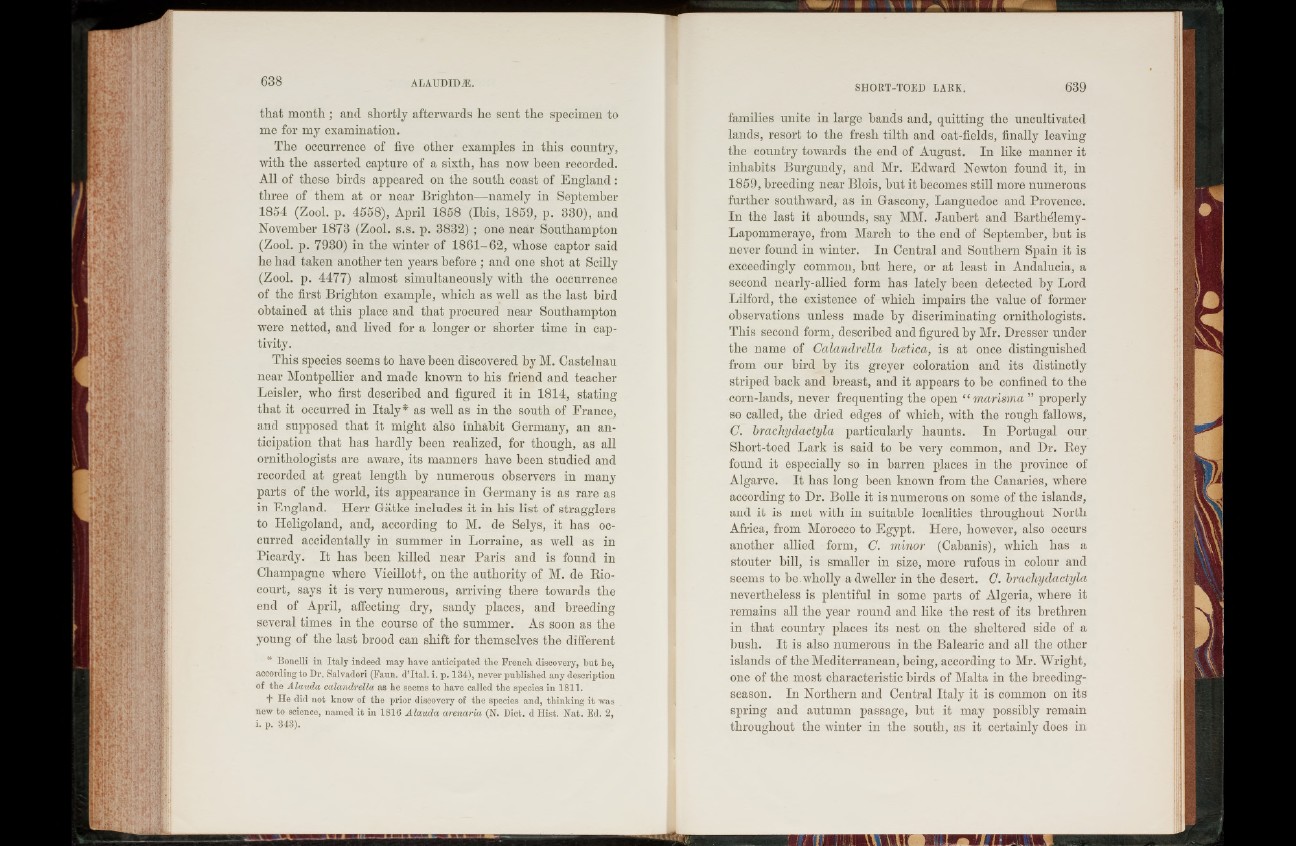
that month; and shortly afterwards he sent the specimen to
me for my examination.
The occurrence of five other examples in this country,
with the asserted capture of a sixth, has now been recorded.
All of these birds appeared on the south coast of England :
three of them at or near Brighton—namely in September
1854 (Zool. p. 4558), April 1858 (Ibis, 1859, p. 330), and
November 1873 (Zool. s.s. p. 3832) ; one near Southampton
(Zool. p. 7930) in the winter of 1861-62, whose captor said
he had taken another ten years before ; and one shot at Scilly
(Zool. p. 4477) almost simultaneously with the occurrence
of the first Brighton example, which as well as the last bird
obtained at this place and that procured near Southampton
were netted, and lived for a longer or shorter time in captivity.
This species seems to have been discovered by M. Castelnau
near Montpellier and made known to his friend and teacher
Leisler, who first described and figured it in 1814, stating
that it occurred in Italy* as well as in the south of France,
and supposed that it might also inhabit Germany, an anticipation
that has hardly been realized, for though, as all
ornithologists are aware, its manners have been studied and
recorded at great length by numerous observers in many
parts of the world, its appearance in Germany is as rare as
in England. Herr Gatke includes it in his list of stragglers
to Heligoland, and, according to M. de Selys, it has occurred
accidentally in summer in Lorraine, as well as in
Picardy. It has been killed near Paris and is found in
Champagne where Vieillotf, on the authority of M. de Kio-
court, says it is very numerous, arriving there towards the
end of April, affecting dry, sandy places, and breeding
several times in the course of the summer. As soon as the
young of the last brood can shift for themselves the different
* Bonelli in Italy indeed may have anticipated the French discovery, but he,
according to Dr. Salvador! (Faun, d’ltal. i. p. 134), never published any description
of the Alauda calandrella as he seems to have called the species in 1811.
Is He did not know of the prior discovery of the species and, thinking it was
new to science, named it in 1816 Alauda arenaria (N. Diet, d Hist. Nat. Ed. 2,
i. p. 343).
SHORT-TOED LARK. 639
families unite in large hands and, quitting the uncultivated
lands, resort to the fresh tilth and oat-fields, finally leaving
the country towards the end of August. In like manner it
inhabits Burgundy, and Mr. Edward Newton found it, in
1859, breeding near Blois, hut it becomes still more numerous
further southward, as in Gascony, Languedoc and Provence.
In the last it abounds, say MM. Jaubert and Barthelemy-
Lapommeraye, from March to the end of September, but is
never found in winter. In Central and Southern Spain it is
exceedingly common, hut here, or at least in Andalucía, a
second nearly-allied form has lately been detected by Lord
Lilford, the existence of which impairs the value of former
observations unless made by discriminating ornithologists.
This second form, described and figured by Mr. Dresser under
the name of Calandrella bcetica, is at once distinguished
from our bird by its greyer coloration and its distinctly
striped back and breast, and it appears to he confined to the
corn-lands, never frequenting the open “ marisma ” properly
so called, the dried edges of which, with the rough fallows,
C. brachydactyla particularly haunts. In Portugal our
Short-toed Lark is said to he very common, and Dr. Bey
found it especially so in barren places in the province of
Algarve. It has long been known from the Canaries, where
according to Dr. Bolle it is numerous on some of the islands,
and it is met with in suitable localities throughout North
Africa, from Morocco to Egypt. Here, however, also occurs
another allied form, C. minor (Cabanis), which has a
stouter bill, is smaller in size, more rufous in colour and
seems to be.wholly a dweller in the desert. C. brachydactyla
nevertheless is plentiful in some parts of Algeria, where it
remains all the year round and like the rest of its brethren
in that country places its nest on the sheltered side of a
hush. I t is also numerous in the Balearic and all the other
islands of the Mediterranean, being, according to Mr. Wright,
one of the most characteristic birds of Malta in the breeding-
season. In Northern and Central Italy it is common on its
spring and autumn passage, hut it may possibly remain
throughout the winter in the south, as it certainly does in